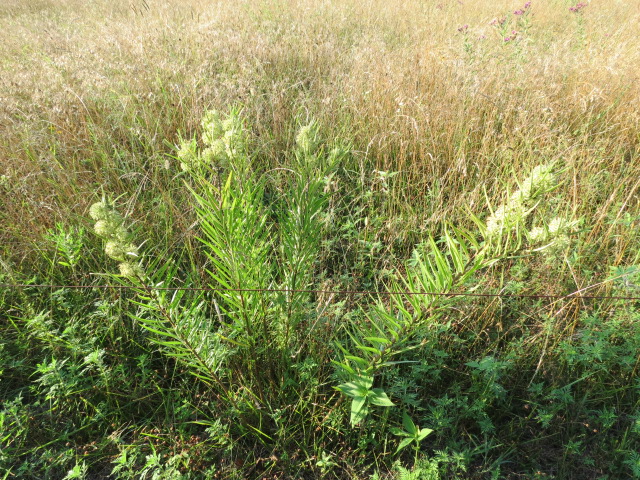
Asclepias hirtella (Tall Green Milkweed, Prairie Milkweed) on 8-3-13, #168-2.
Prairie Milkweed, Tall Green Milkweed
Asclepias hirtella
ass-KLE-pee-us sten-oh-FIL-uh
Synonyms of Asclepias hirtella (4) ) (Updated on 11-16-23 from Plants of the World Online): Acerates hirtella Pennell, Asclepias longifolia var. hirtella (Pennell) B.L.Turner, Asclepias longifolia subsp. hirtella (Pennell) J.Farmer & C.R.Bell, Oligoron longifolium var. hirsutum Raf.
Asclepias hirtella (Pennell) Woodson is the accepted scientific name for the Prairie Milkweed. It was named and described as such by Robert Everard Woodson in the Annals of the Missouri Botanical Garden in 1941. It was first named and described as Acerates hirtella by Francis Whittier Pennell in the Bulletin of the Torrey Botanical Club in 1919.
The genus, Asclepias L., was named and described by Carl von Linnaeus in the first volume of the first edition of Species Plantarum in 1753.
As of 11-16-23 when this page was last updated, Plants of the World Online by Kew lists 204 accepted species in the Asclepias genus. It is a member of the plant family Apocynaceae with 376 genera. Those numbers could change as updates are made on POWO.

Distribution map of Asclepias hirtella from Plants of the World Online. Facilitated by the Royal Botanic Gardens, Kew. Published on the Internet; http://www.plantsoftheworldonline.org/. Retrieved on April 9, 2021.
The distribution map above for Asclepias hirtella is from Plants of the World Online. The map on the USDA Plants Database for North America above Mexico is the same.
The map on iNaturalist shows where members have made observations. Anyone can join and it is a great website to confirm and share your observations. The maps on iNaturalist are continually updated as members post new observations.
THERE ARE SEVERAL LINKS AT THE BOTTOM OF THE PAGE FOR FURTHER READING AND TO HELP WITH A BETTER POSITIVE ID.

Asclepias hirtella (Tall Green Milkweed, Prairie Milkweed) on 8-3-13, #168-3.
There are several species of Milkweeds growing on the farm and in other areas where I go wildflower hunting. Asclepias hirtella, also known as the Prarie Milkweed and Tall Green Milkweed, was one of the first I observed on the farm in 2013. Back then, the only other Milkweed was the Asclepias syriaca (Common Milkweed) that grows along the edge of the lagoon (now they grow in abundance in the main hayfield and back pasture). I noticed that once the hay is cut, the A. hirtella will grow and rebloom… As with all Milkweeds, it is a very beneficial species for a multitude of insects.
Asclepias hirtella is a perennial wildflower that is a less common Milkweed found in pastures, prairies, and along roadsides in the area. They prefer full sun and grow in a variety of soils and conditions. They are very easy to recognize with mostly white flowers without corolla horns and narrow leaves.
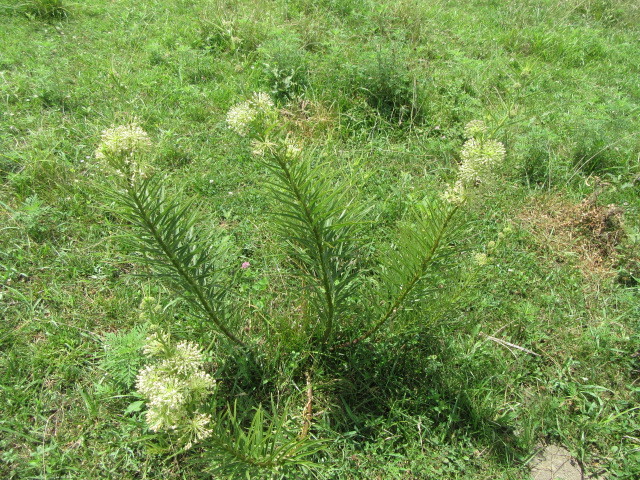
Asclepias hirtella (Tall Green Milkweed, Prairie Milkweed) on 7-16-19, #602-1.
They grow multiple single stems from the base which can be either smooth (glabrous) or have very fine short hairs (densely pubescent). The stems can be light green, reddish-green, or a combination of the two.

Asclepias hirtella (Tall Green Milkweed, Prairie Milkweed) on 7-16-19, #602-2.
Hmmm… Clusters (umbels) of flowers grow from axils of the mid to upper leaves, 2-10 per stem and usually 1 per leaf node… Each umbel produces 25-100 flowers on short, slender, light green pedicels. Peduncles and pedicels are densely pubescent. Peduncles are the stems between the leaf axils and umbel, while pedicels attach the flowers to the peduncles…
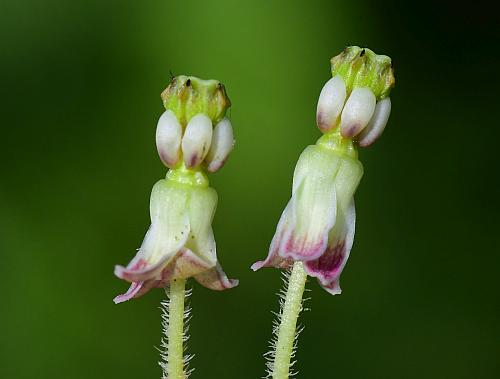
The above photo of Asclepias hirtella flowers is from the Missouri Plants website. Missouri Plants is published on the internet at http://www.missouriplants.com/index.html. Photo used by permission and retrieved on January 21, 2024.
Greenish white flowers with purplish tips or spots, approximately 1/8” across. Flowers have 5 sepals, a corolla with 5 reflexed lobes, and 5 upright corona hoods without horns. The corolla lobes are greenish-white with tinting at the tips, and the corona hoods are whitish with purple markings at the base.
Plants begin flowering in May. Here on the farm, if hay is cut, this milkweed often regrows and blooms again (depending on when the hay is cut).
I borrowed the above photos from the Missouri Plants website until I can take one as good… Hmmm… The Missouri Plants is provided by the Missouri Botanical Garden.

Asclepias hirtella (Prairie Milkweed) on 8-8-22, #903-1.
The leaves grow alternately along the stems and are narrow and lance-shaped (narrowly lanceolate) with sharp points. The leaves have short hairs making them rough to the touch. The leaves usually curve upward along each side of the central vein giving them a V-shape like a boat. Sometimes the entire leaf may curve upward…
<<<<2021>>>>

Asclepias hirtella (Tall Green Milkweed, Prairie Milkweed) on 9-28-21, #836-2.
The smooth dehiscent (opening from a single split) seed pods (follicles) are 4-5” long and grow from the pistils of fertile flowers.

Asclepias hirtella (Tall Green Milkweed, Prairie Milkweed) on 10-24-21, #851-7.
Once the fruit dries, it splits open revealing the fuzzy seed… Or a seed with a lot of white hair. 🙂
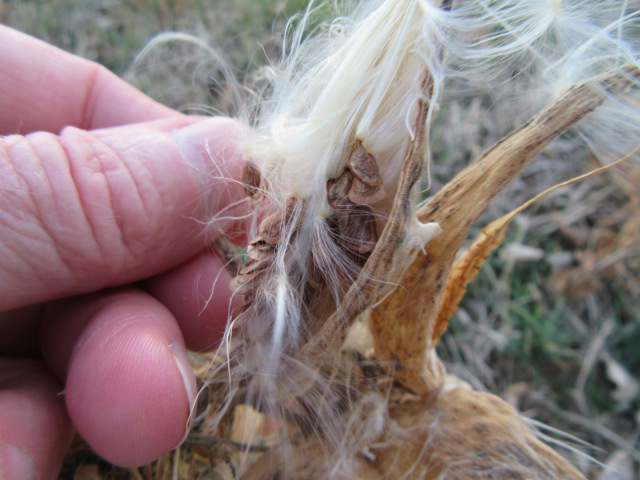
Asclepias hirtella (Tall Green Milkweed, Prairie Milkweed) on 12-12-21, #859-7.
When the seed pod is really dry, it splits open even more… The seed floats through the air and can travel quite far on windy days.

Ponometia canefacta (Olive-Shaded Bird-Dropping Moth) on a Asclepias hirtella on 9-1-22, #907-23.
If you want to photograph a variety of butterflies and other insects, milkweeds are a great place to start.

Tarache aprica (Exposed Bird Dropping Moth) on a Asclepias hirtella on 9-1-22, #907-31.
Hmmm… Two species of Bird Dropping Moths on the same day. Well, there are a lot of other species of butterflies and bugs on milkweeds, but I had probably photographed them on other species that day. I’ll get more photos specifically feeding on Asclepias hirtella in 2024…
I found a good write-up called, “The Story of an Organism: Common Milkweed” by Craig Holdrege from The Nature Institute. You Can read it by clicking HERE… It’s quite a story that leaves nothing out about Milkweeds.
There are more photos at the bottom of the page.
Asclepias hirtella can be distinguished from other Milkweed species by its long, narrow leaves that grow alternately along the stems rather than opposite like other Milkweeds. Flowers are greenish-white and lack “horns” in the hoods of the flowers. Asclepias hirtella produces more umbels per plant than most other Milkweed species…
I live on a small farm in Windsor, Missouri where I enjoy gardening, collecting plants, and identifying wildflowers. The farm is in Pettis County but Henry County is across the street, and Benton and Johnson aren’t far away. I have grown over 500 different plants and identified over 250 species of wildflowers (most have pages listed on the right side of the page). I am not an expert, botanist, or horticulturalist. I just like growing, photographing, and writing about my experience. I rely on several websites for ID and a few horticulturalists I contact if I cannot figure them out. Wildflowers can be somewhat variable from location to location, so sometimes it gets a bit confusing. If you see I have made an error, please let me know so I can correct what I have written.
I hope you found this page useful and be sure to check the links below for more information. They were written by experts and provide much more information. Some sites may not be up-to-date but they are always a work in progress. If you can, I would appreciate it if you would click on the “Like” below and leave a comment. It helps us bloggers stay motivated. You can also send an email to me at thebelmontrooster@yahoo.com. I would enjoy hearing from you especially if you notice something is a bit whacky.
FOR FURTHER READING:
PLANTS OF THE WORLD ONLINE (GENUS/SPECIES)
INTERNATIONAL PLANT NAMES INDEX (GENUS/SPECIES)
TROPICOS (GENUS/SPECIES)
FLORA OF MISSOURI (GENUS/SPECIES)
WORLD FLORA ONLINE (GENUS/SPECIES)
WIKIPEDIA (GENUS/SPECIES)
USDA PLANTS DATABASE
DAVE’S GARDEN
MISSOURI PLANTS
MISSOURI BOTANICAL GARDEN
MISSOURI DEPARTMENT OF CONSERVATION
SAVE THE DUNES
iNATURALIST
WILDFLOWER SEARCH
ILLINOIS WILDFLOWERS
MINNESOTA WILDFLOWERS
KANSAS WILDFLOWERS AND GRASSES
LADY BIRD JOHNSON WILDFLOWER CENTER
FLORA OF WISCONSIN
KANSAS NATIVE PLANTS
MINNESOTA DEPARTMENT OF NATURAL RESOURCES
NOTE: The data (figures, maps, accepted names, etc.) may not match on these websites. It depends on when and how they make updates and when their sources make updates. Some websites have hundreds and thousands of species to keep up with. Accepted scientific names change periodically and it can be hard to keep with as well. Some of the links may use a name that is a synonym on other sites. In my opinion, Plants of the World Online by Kew is the most reliable and up-to-date plant database and they make updates regularly. I make updates “at least” once a year and when I write new pages or add new photos but I do get behind. We are all a work in progress. 🙂
MORE PHOTOS FROM…

Asclepias hirtella (Tall Green Milkweed, Prairie Milkweed) on 6-14-20, #710-11.

Asclepias hirtella (Tall Green Milkweed, Prairie Milkweed) on 12-12-21, #859-6.

Asclepias hirtella (Prairie Milkweed) on 8-8-22, #903-2.

Asclepias hirtella (Prairie Milkweed) on 8-8-22, #903-3.
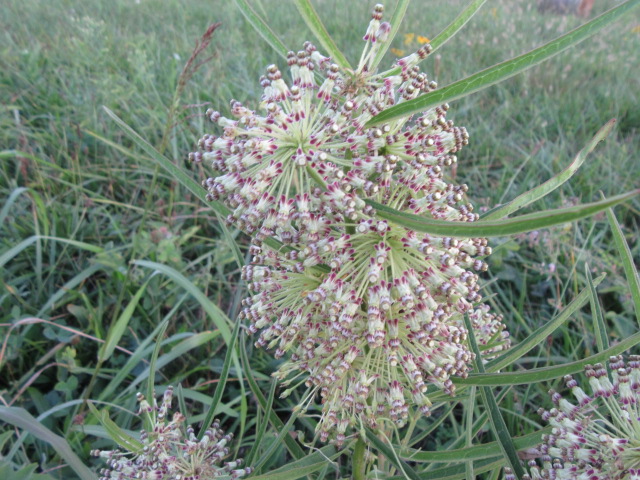
Asclepias hirtella (Prairie Milkweed) on 9-1-22, #907-1.
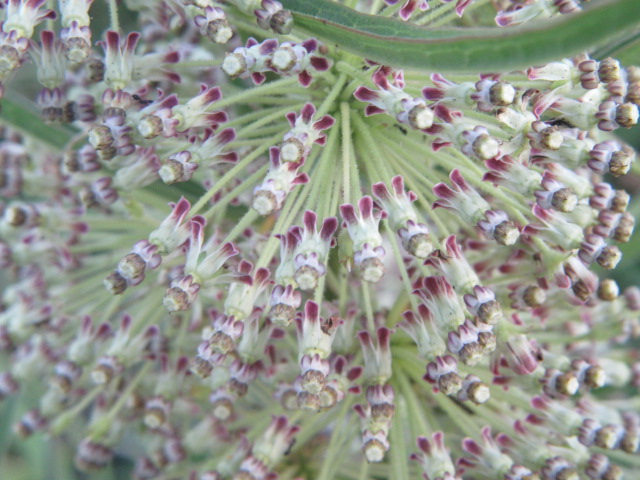
Asclepias hirtella (Prairie Milkweed) on 9-1-22, #907-2.
PHOTOS FROM 2023…

Asclepias hirtella (Prairie Milkweed) on 6-8-23, #945-1.

Asclepias hirtella (Prairie Milkweed) on 6-8-23, #945-2.